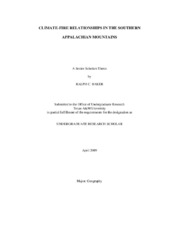| dc.description.abstract | This study is meant to explain the fire regime of the southern Appalachian Mountain Range of the southeastern United States by analyzing spatial statistics and climate-fire relationships. The spatial statistics were created by obtaining then computing data from the National Interagency Fire Management Integrated Database (NIFMID), which has covered fires in national forests since approximately 1970, and the Continuous Inventory of Stand Condition (CISC) database. Once the data was computed it was entered into GIS software where it was spatially analyzed. Climatic teleconnections relate the anomalies in the atmosphere across the globe; they have been theorized to affect weather. The numeric representations of selected teleconnections were collected from the National Oceanic and Atmospheric Administration (NOAA) and correlated to fire history data from the NIFMID dataset. The correlations were analyzed to determine which teleconnections and at what time period affect fires in the region. Annual statistics about the fire history were correlated to the teleconnections of each of the previous 24 months. The study found that the fire regime can be described as consisting of three distinct fire seasons: spring anthropogenic, summer lightning and fall anthropogenic. Spring and fall are prime fire seasons because of the combined climate conditions of it being dry and windy. Summer conditions are not as favorable for fire, but that is primarily when lightning occurs. PDSI was found to strongly correlate (above the .001 significance level) to fire as would be expected in a humid climate. Anthropogenic fires were shown to correlate significantly (above the .05 significance level) to all teleconnections for at least one of the 24 months. Lightning fires did so for some of the teleconnections. After looking at the spatial statistics of fire in the study area, the general patterns observed were that fire was most impactful in north-western Georgia, eastern Tennessee and northwestern North Carolina and that fires in other areas, though plentiful, were small. | en |


